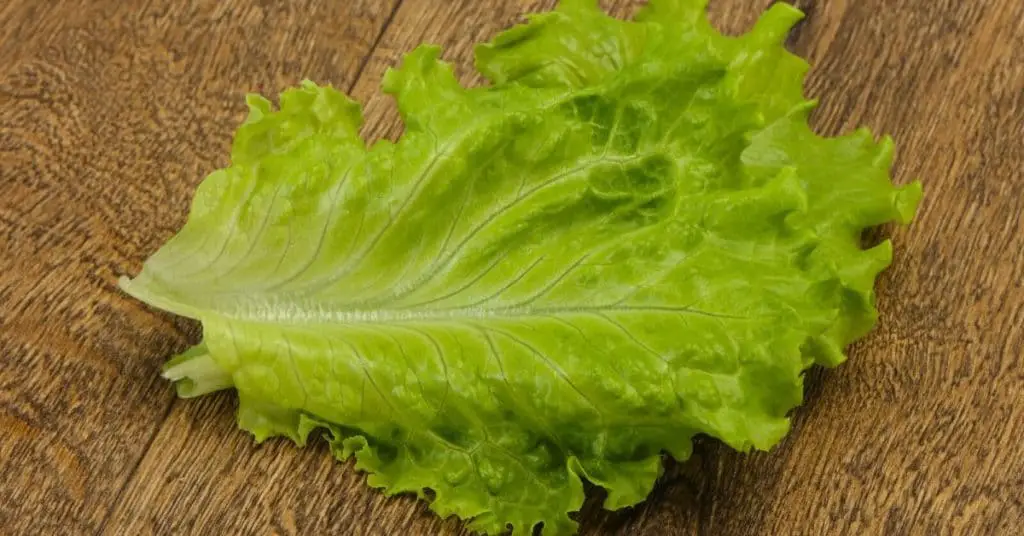Briefly, yes, you can freeze lettuce, but only for cooked meals, smoothies, or soup, as freezing will make lettuce leaves soggy and mushy for fresh salads.
Crispy and nutritious, lettuce is used mainly as a base for salads or on sandwiches. As a freshly grown and harvested product with high water content, lettuce has a relatively short shelf life, and the leaves don’t handle extreme temperature changes well.
Whether you grow your own lettuce, get from your local farmers market, or buy it in-store, there is an intriguing variety of leafy greens out there for salad and sandwich-making. But what if you’ve harvested more than your household can handle?
Don’t worry. There are ways in which you can freeze lettuce and use it, making it possible to buy in bulk and not waste any of your garden harvests
Can Lettuce Be Frozen?
If you plan to add lettuce to cooked meals, smoothies, or soup, then YES, you can freeze lettuce. Freezing is, however, not possible for keeping lettuce to make fresh salads as frozen lettuce leaves structurally denature on freezing.
Once thawed, lettuce leaves become soggy, mushy, and unappetizing to eat. During the process of freezing, the water in plant cells forms ice crystals. These ice crystals expand and damage the plant cell walls weakening the structure and causing a softer texture.
Vegetables with a high starch content and little water can withstand some of the damage and retain their structure. Due to its high water content and delicate cell walls, lettuce, however, cannot withstand freezing temperatures and will ultimately lose their crisp texture.
The best types of leafy salad greens to freeze are the slightly denser varieties such as romaine, butterhead, baby spinach, and rocket.
How To Freeze Lettuce
The fragile and perishable nature of lettuce makes it a tricky product to preserve. Although your greens will not be suitable for use in salads or on sandwiches after freezing, there are two techniques you can use to freeze your greens for use in lettuce soup, as pureed lettuce in smoothies, and in other delicious ways.
Freezing Option 1: Leaves
Step 1: Sort
Separate the lettuce leaves from one another and remove or cut away any tired or discolored leaves. Cut and discard the stalk if freshly harvested.
Step 2: Wash
Wash the leaves thoroughly with water to remove sand, bugs, chemicals, and bacteria.
Step 3: Dry
Ideally, dry the leaves in a salad spinner. If you do not have one, you can drain the leaves in a colander and blot them dry with a clean kitchen towel or paper towels to remove all the outer moisture.
Keep in mind that any extra water left on the lettuce will further exacerbate the formation of ice crystals, damaging the fragile leaves and causing freezer burn.
Step 4: Bag & Seal
Place the washed and dried leaves in good quality, sealable freezer bags. Gently press out all the air to retain the freshness and flavor of the leaves. Seal the packet. If you have more than one variety of lettuce, you may want to keep them in separate bags.
Freezing Option 2: Puree
Step 1: Sort
Remove or cut away any tired or discolored leaves and stems.
Step 2: Wash
Wash the leaves thoroughly with water to remove sand, insects, chemicals, and bacteria.
Step 3: Lightly Dry
Place the leaves in a colander to shake off most of the water. Alternatively, blot them lightly with a clean kitchen towel. Since you are going to puree the batch, it is not a problem if there is still some moisture on the leaves.
Step 4: Blend
Place the cleaned and washed leaves into your blender and blend well at high speed. Use the plunger to press the leaves down if needed and keep adding more leaves as they break down to a pulpy green puree.
Step 5: Freeze in Ice Tray
Pour the puree into ice cube trays and place it in the freezer till frozen completely.
Step 6: Transfer to Bag
Once fully frozen, remove the ice cubes and place them in a zip lock freezer bag in the freezer until ready to use in smoothies, soups, casseroles, or curries.
How To Thaw Lettuce
Lettuce can be added frozen or thawed to smoothies, soups, and stews. Take the following steps to defrost frozen lettuce safely.
Option 1: Refrigerate
Remove the bag of lettuce from the freezer and place it in the refrigerator to thaw overnight.
Option 2: Room Temperature
Remove the bag of lettuce from the freezer and keep it at room temperature for one or two hours. Place the freezer bag on a dish towel or plate while thawing to prevent water from staining your countertop. Once defrosted, place it in the fridge if not using immediately.
Common Types of Lettuce
With a variety of colors, flavors, leaf shapes, and sizes, lettuce types combine to make delicious salads and add to your cooking. These are the most popular types of lettuce:
Leaf Lettuce
Also known as loose-leaf lettuce, these loosely bunched leaves are used mainly for salads. They come in a variety of frilly leaf colors, including greens, reds, and oak.
Romaine Lettuce
Also known as Cos lettuce, this is one of the most widely consumed lettuce types used predominantly for sandwiches and salads.
Iceberg Lettuce
Iceberg or crisphead lettuce is crunchy and light in color. It is sensitive to heat, light in flavor, and not a good option for freezing due to its exceptionally high water content.
Butterhead Lettuce
Known for its tender texture and slight sweetness, this variety constitutes a loose arrangement of leaves. This is also called Boston or Bibb lettuce.
Summercrisp Lettuce
Also known as Batavian or French crisp lettuce, these large, flavorful leaves make for great salads.
Rocket Lettuce
Also referred to as arugula, the small peppery dark green leaves are great to mix with milder lettuce types for a spicy pop of flavor. They are also ideal for adding to sandwiches, wrapping, making pesto, or topping pizza.
FAQs
Conclusion
Contrary to popular belief, extra lettuce that does not have an immediate purpose in your kitchen doesn’t have to be tossed in the bin. Blend it, bag it, freeze it…there is so much deliciousness you can still get out of your greens.
Adding it frozen to a berry smoothie will provide you with an icy beverage that contains hidden nutrients that you would hardly detect coming from greens. No spinach to add to your casserole? No problem. Just grab a stash of frozen lettuce from the freezer, and you are sorted.
Keep in mind that a fair amount of water will be released on cooking from frozen. Always take this into account when calculating cooking time and determining the desired consistency of your dish. Alternatively, thaw your greens before adding.
Discovering the concept of frozen greens is almost like discovering a new ingredient for your pantry. Have fun cooking!
Related: Can You Freeze Chicken Salad?
Image by depositphotos/AndreySt









